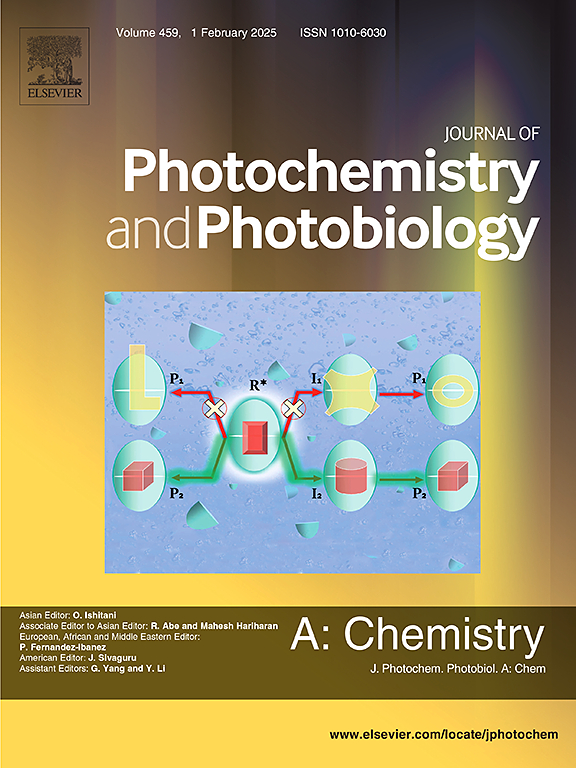一种新型氮掺杂多孔碳负载g-C3N4复合材料增强光催化CO2转化
IF 4.1
3区 化学
Q2 CHEMISTRY, PHYSICAL
Journal of Photochemistry and Photobiology A-chemistry
Pub Date : 2025-04-22
DOI:10.1016/j.jphotochem.2025.116454
引用次数: 0
摘要
太阳能驱动的二氧化碳转化为碳氢化合物燃料被认为是减少大气中二氧化碳丰度和满足能源需求的最重要的发明之一。石墨化氮化碳(g-C3N4)由于其吸收可见光、不含金属和对环境无害的特性,已经引起了人们的广泛关注,并成为光催化CO2还原的有希望的候选者。然而,由于其相对较小的比表面积、快速的电子-空穴复合速率和有限的CO2吸附能力等因素,限制了其有效实现这一目标的能力,也限制了其实际应用。在不影响g-C3N4光吸收能力的情况下,将适量的ZIF-8衍生的n掺杂多孔碳掺入g-C3N4中,合成了一种新型光催化剂。采用x射线衍射(XRD)、透射电子显微镜(TEM)、傅里叶变换红外光谱(FT-IR)、氮和二氧化碳吸附测量、x射线光电子能谱(XPS)、紫外-可见漫反射吸收光谱(UV-DRS)和光致发光光谱(PL)对制备的样品进行了表征。与g- c3n4相比,优化后的光催化剂比表面积增加54倍,CO2吸附量增加3.5倍,光带隙减小,CO2还原活性显著提高,CH4的产率为70.87 μmol h−1 g−1,C2H6的产率为35.31 μmol h−1 g−1。复合材料的活性增强是由于n掺杂碳和g-C3N4的协同作用。因此,这种方法为未来开发基于c3n4的高效太阳能到燃料转换催化剂提供了一种有希望的策略。本文章由计算机程序翻译,如有差异,请以英文原文为准。

A novel N-doped porous carbon-supported g-C3N4 composite for enhanced photocatalytic CO2 conversion
The solar light-driven CO2 conversion into hydrocarbon fuels is regarded as one of the most crucial inventions to reduce CO2 abundance in the atmosphere and fulfill energy needs. Graphitic carbon nitride (g-C3N4) has garnered considerable attention and emerges as a promising candidate for photocatalytic CO2 reduction, owing to its visible light absorption, metal-free, and environmentally benign nature. However, its ability to effectively achieve this is currently hindered by several factors such as relatively low surface area, fast electron-hole recombination rate and limited CO2 adsorption capacity, which also constrain its practical applicability. In this work, a novel photocatalyst was synthesized by incorporating a suitable amount of ZIF-8 derived N-doped porous carbon into g-C3N4 without affecting its light absorption capacity. The as-prepared samples were characterized by X-ray diffraction (XRD), transmission electron microscopy (TEM), Fourier transform infrared spectroscopy (FT-IR), nitrogen and CO2 adsorption measurements, X-ray photoelectron spectroscopy (XPS), UV–Vis diffuse reflectance absorption spectra (UV-DRS), and photoluminescence spectroscopy (PL). Compared to g-C3N4, the optimized photocatalyst exhibited a 54-fold increase in surface area, a 3.5-fold enhancement in CO2 adsorption capacity, a reduced optical bandgap, and significantly superior photocatalytic activity for CO2 reduction, achieving CH4 production at 70.87 μmol h−1 g−1 and C2H6 production at 35.31 μmol h−1 g−1. The enhanced activity of the composites is attributed to the synergistic effect of the N-doped carbon and g-C3N4. Thus, this approach offers a promising strategy for the future development of C3N4-based catalysts for efficient solar to fuel conversion.
求助全文
通过发布文献求助,成功后即可免费获取论文全文。
去求助
来源期刊
CiteScore
7.90
自引率
7.00%
发文量
580
审稿时长
48 days
期刊介绍:
JPPA publishes the results of fundamental studies on all aspects of chemical phenomena induced by interactions between light and molecules/matter of all kinds.
All systems capable of being described at the molecular or integrated multimolecular level are appropriate for the journal. This includes all molecular chemical species as well as biomolecular, supramolecular, polymer and other macromolecular systems, as well as solid state photochemistry. In addition, the journal publishes studies of semiconductor and other photoactive organic and inorganic materials, photocatalysis (organic, inorganic, supramolecular and superconductor).
The scope includes condensed and gas phase photochemistry, as well as synchrotron radiation chemistry. A broad range of processes and techniques in photochemistry are covered such as light induced energy, electron and proton transfer; nonlinear photochemical behavior; mechanistic investigation of photochemical reactions and identification of the products of photochemical reactions; quantum yield determinations and measurements of rate constants for primary and secondary photochemical processes; steady-state and time-resolved emission, ultrafast spectroscopic methods, single molecule spectroscopy, time resolved X-ray diffraction, luminescence microscopy, and scattering spectroscopy applied to photochemistry. Papers in emerging and applied areas such as luminescent sensors, electroluminescence, solar energy conversion, atmospheric photochemistry, environmental remediation, and related photocatalytic chemistry are also welcome.

 求助内容:
求助内容: 应助结果提醒方式:
应助结果提醒方式:


